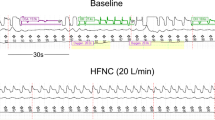Abstract
The effect of inhaled long-acting β2-agonists in obstructive sleep apnea syndrome (OSAS) is unknown, although from the pharmacological point of view both therapeutic and adverse effects need to be considered. The purpose of this study was to obtain data on the efficacy and safety of salmeterol in patients with OSAS. In a randomized, double-blind, placebo-controlled, cross-over study, effects of salmeterol on respiration during sleep and sleep quality were investigated in 20 patients with OSAS. Of these, 4 patients were female, 16 male; the average age was 53.0 ± 7.8 years, with average body mass index 28.0 ± 3.0 kg· m-2 and average apnea hypopnea index 35.6 ± 17.8 h-1. Patients with asthma, chronic obstructive pulmonary disease (COPD), and left heart failure were excluded. Placebo or verum (50 μg salmeterol) was administered at 7 pm by meter dose inhaler and spacer device. All patients underwent full polysomnography during baseline, placebo, and verum night. Statistical analysis was performed by Student’s t-test (p > 0.05). Between the placebo and verum there were no differences in total sleep time, sleep stages, apnea index (AI), apnea hypopnea index (AHI), and nadir oxygen saturation. There was, however, 1) a significant deterioration of mean oxygen saturation (SaO2m; placebo 93.1 ± 2.0 vs. verum 92.5 ± 2.2%; p = 0.01), 2) of percent of time spent with an oxygen saturation (SaO2) ≤ 90% (placebo 13.1 ± 14.5 vs. verum 19.5 ± 20.8%; p = 0.02), and 3) a significant increase in heart rate (placebo 63.1 ± 9.2 vs. verum 65.6 ± 9.3 h-1; p = 0.01). In patients with OSAS, salmeterol had no adverse effect on quality of sleep, AI or AHI. The slight increase in heart rate and the deterioration of oxygen saturation probably have no clinical relevance; the latter condition might be due to ventilation-perfusion-mismatch. This study excluded any influence of salmeterol on obstructive sleep apnea and hypopnea; on the other hand, salmeterol turned out to be safe in terms of OSAS. This might be of special importance in patients suffering from both OSAS and obstructive airway disease.
Similar content being viewed by others
References
Brownell LG, West P, Sweatman P, Acres JC, Kryger MH. Protriptyline in obstructive sleep apnea. A double blind trial. N Engl J Med 1987;307:1037–1042
Guilleminault C, Hayes B. Naloxone, theophylline, bromocriptine, and obstructive sleep apnea: negative results. Bull Eur Physiopathol Respir 1983;19:632–634
Krieger J, Mangin P, Kurtz D. Effects of almitrine in the treatment of sleep syndromes. Bull Eur Physiopath Respir 1983;19: 630
Orr WC, Imes NK, Martin RJ. Progesterone therapy in obese patients with sleep apnea. Arch Intern Med 1979;139:109–111
Peter JH, Amend G, Stephan S, et al. Therapie der Schlafapnoe mit abendlich eingenommenem retardierten Theophyllin (Euphylong). Prax Klin Pneumol 1987;41:433–437
Pillar G, Schnall R, Odeh M, Oliven A. Amelioration of sleep apnea by salicylate-induced hyperventilation. Am Rev Respir Dis 1992;146:711–715
Rajagopal KR, Abbrecht PH, Jabbari B. Effects of medroxyprogesterone acetate in obstructive sleep apnea. Chest 1986;90: 815–821
Smith L, Haponik E, Allen R, Bleecher ER. The effects of protriptyline in sleep disordered breathing. Am Rev Respir Dis 1983;127:8–13
Strohl KP, Hensley MH, Saunders NA et al. Progesterone administration and progressive sleep apneas. J Amer Med Ass 1980; 245:1230–1232
Strohl KP, Cherniack NS, Gothe N. Physiologic basis of therapy of sleep apnea. Am Rev Respir Dis. 1986;134:791–802
Deutsche Gesellschaft für Pneumologie. Empfehlungen zur Diagnostik und Therapie nächtlicher Atmungs- und KreislaufregulationsstöUrungen. Pneumologie 1991;45:45–48
Orth M, Rasche K, Kollhosser P, Duchna H-W, Schultze-Wern-inghaus G. Effect of theophylline on oxygen saturation and ventilation in obstructive sleep apnea syndrome. Am J Respir CritCare Med 1995;151,4:A537
Sullivan CE, Issa FG, Berthon-Jones M, Eves L. Reversal of obstructive sleep apnea by contiuous positive airway pressure applied through the nares. Lancet 1981;1:862–865
Ferner H, Staubesand J. Sobotta - Atlas der Anatomie des Menschen. München - Wien - Baltimore: Urban & Schwarzen berg;1982: 192–193
Dirnagl K: Aerosole in der Medizin. Wirkungsweise und Methodik der Aerosoltherapie. Prax Klin Pneumol 1982;36: 365–367
Rhodes DG, Newton RF, Butler R, Herbette L. Equilibrium and kinetic studies of the interactions of salmeterol with membrane bilayers. Mol Pharmacol 1992;42:596–602
Brogden RN, Faulds D. Salmeterol Xinafoate. A review of its pharmacological properties and therapeutic potential in reversible obstructive airways disease. Drug 1991;42:895–912
Douglas NJ, Fitzpatrick MF. Effects of salmeterol on nocturnal asthma. Eur Respir Rev 1991;1:293–296
Rechtschaffen A, Kales A. A manual of standardized terminology, techniques, and scoring system for sleep stages of human subjects. NIH publ No. 204, US Government Printing Office, Washington DC, 1968
Flenley DC. Sleep in chronic obstructive pulmonary disease. Clin Chest Med 1985;328:1230–1250
Chaouat A, Weitzenblum E, Krieger J et al. Association of chronic obstructive pulmonary disease and sleep apnea syndrome. Am J Respir Crit Care Med 1995;151:82–86
Orth M, Rasche K, Bauer TT, Duchna H-W, Kollhosser P, Schultze-Werninghaus G. Häufigkeit der chronisch-obstruktiven Atemwegserkrankung bei Patienten mit obstruktivem Schlafapnoe-Syndrom. Pneumologie 1996;50:286–289
öUnal E, Leech JA, Lopata M. Relationship between pulmonary function and sleep-induced respiratory abnormalities. Chest 1985;87:437–441
Author information
Authors and Affiliations
Rights and permissions
About this article
Cite this article
Rasche, K., Duchna, HW., Lauer, J. et al. Obstructive Sleep Apnea and Hypopnea Efficacy and Safety of a Long-Acting β2-Agonist. Sleep Breath 3, 125–129 (1999). https://doi.org/10.1007/s11325-999-0125-1
Issue Date:
DOI: https://doi.org/10.1007/s11325-999-0125-1




